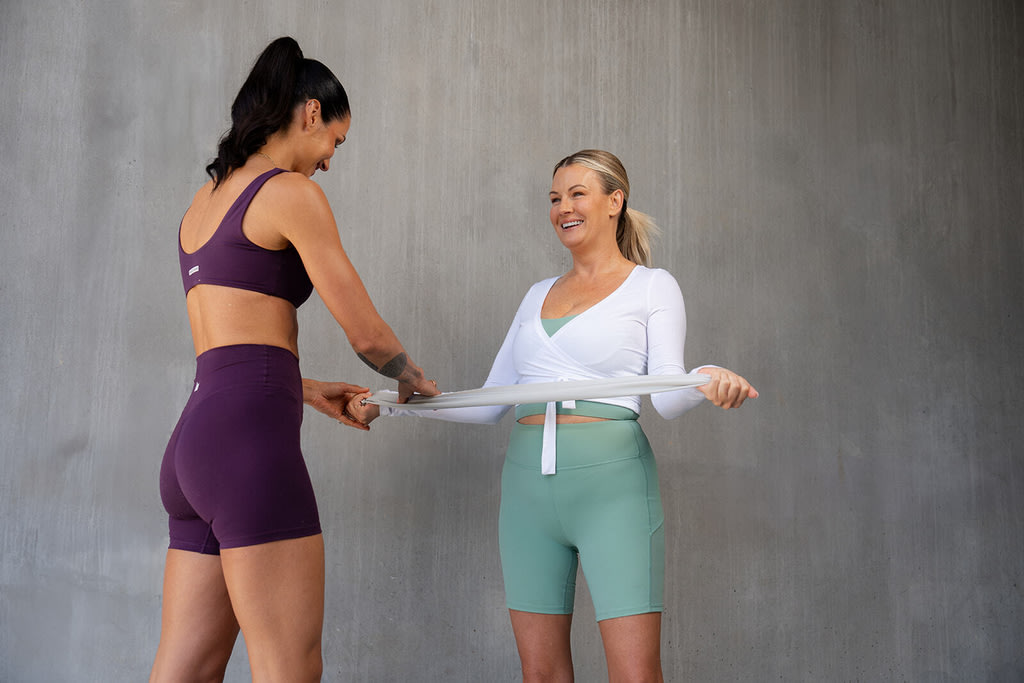The 6 Most Surprising Things About Returning To Exercise After Having A Baby
Kickstarting your postpartum fitness routine is far from a walk in the park.

July 23, 2025 - Updated July 23, 2025

So, your healthcare provider has given you the all-clear to start working out again after giving birth? Before you hit “start workout” on your first post-pregnancy session in the Sweat app, there are a few things you need to know…
It’s a slower process than you could possibly imagine
Take the amount of time you thought it would take to get back to your pre-baby fitness. Now double it. Now double it again. Now we’re getting close to a realistic timeline – although you may like to double it again, just to be on the safe side.
Women’s bodies recover remarkably after birth, but it’s a major change - not to mention, for those who’ve had a caesarean (aka major surgery), the expectation that your body will be ready to hit the gym again after only a few days at home with your bub is, unfortunately, not quite the reality.
While, according to the American College of Obstetricians and Gynecologists (ACOG), it’s safe to begin exercising soon after giving birth vaginally (assuming you didn’t have birth complications), the level of exercise you feel comfortable with will likely be significantly less than your pre-pregnancy level. In fact, the Royal Women’s Hospital Victoria suggests you avoid strenuous exercise like running, sit-ups and weight-lifting until your baby is at least 12 weeks old.
And that’s only the medical aspect of returning to exercise after a baby. Whether you have the time, the inclination or the ability to get moving will entirely depend on your circumstances: for some women, getting out walking with the pram helps keep them sane, while for others the prospect of strapping on their joggers and leaving the house during the “fourth trimester” is unthinkable.
No matter how keen you are, or how good your intentions were before your baby was earthside, regaining fitness after pregnancy is a slow process. Forget the pressure to “bounce back”: your body has been through the wringer, and you won’t be bouncing anywhere for a couple of months.
The type of exercise you do will change
You heard it here first: motherhood is humbling in more ways than one. Your pre-baby gym routine? Rip it up - for the first few months to a year, anyway. The focus in the early days, ACOG says, should be on strengthening your muscles and rebuilding your pelvic floor, in addition to slowly introducing light to moderate aerobic exercise like walking.
For those who get a rush from running or lifting, this can be a real adjustment period. Your mind might be ready for a full-on HIIT session, but your body is more in the market for gentle core work, such as Britany’s Post-Pregnancy Core & Restore program, which is designed to help improve and minimise postnatal issues such as diastasis recti, pelvic floor and core dysfunction.
Not being able to pick up where you left off before your pregnancy can be frustrating, but pacing yourself is worth it. Although it might seem a million years away, your strength and stamina will improve over time, and – most importantly – you’ll avoid overdoing it and injuring yourself by taking it easy to start.
Following a program specifically designed for postpartum women is one of the easiest ways to ensure you don’t jump the gun by going too hard on the crunches in the early days.
The “best” time to work out? It doesn’t exist
Your baby is sleeping soundly and won’t wake for another hour. The dishwasher is unloaded, the laundry is folded, the floors have been vacuumed and you’ve made that phone call to the health insurer you’ve been putting off for weeks. You’re well-slept, showered, full, and have had just enough coffee that you’re feeling buzzed but not so much that your soul is ready to leave your body. Now you’re ready to start your workout.
Hahaha! Just kidding. That was a fever dream brought on by sleep deprivation. The chances of “perfect” workout conditions as a new parent are about the same as your newborn sleeping through the night, namely: infinitesimal. Hell will freeze over before your leggings are vomit-free. The hard truth is, there’s never going to be a perfect time to get moving, or even a particularly good time - just a time that’s slightly less inconvenient than all the others.
But it’s okay if your workout looks like 15 minutes of gentle stretching on the nursery floor pieced together between rocking and dummy-replacing while shhhhh-ing frantically under your breath. It’s okay if your workout is a walk with a pram (and it’s okay if the baby inside that pram is screaming. Trust us.). It’s okay if it takes you three hours and four newborn sleep cycles to actually finish what you set out to do, and it’s also okay if some days you do nothing at all, and fall asleep on the carpet between side-planks instead.
Everything in your life looks different after having your baby, and your fitness routine will too. The sooner you accept that, the sooner you can get down to the business of actually getting something – anything – done.
Your relationship with your body will change entirely, in a good way
The ability to grow another human inside you is a miracle. Sustaining that new life, every day, with nothing but your own body, is nothing short of exceptional. Whether your birth was vaginal or by caesarean, your baby is breast or bottle-fed, one thing is true for absolutely every new mother: before and after your pregnancy, your body is your baby’s home, their safe space and their sanctuary.
In that context, the appearance of your body, which grew and birthed the most important thing in your world, might suddenly seem… kind of insignificant. That’s not to say that dealing with changes in your body during and after pregnancy can’t be difficult, or that you’ll be magically free of criticism every time you look in the mirror. But you won’t ever lose the appreciation for how incredible your body is - and the way you approach exercise will adjust accordingly.
… And so will what you want from your fitness routine.
That’s not to say that sprinters will chuck out their running shoes or yogis will fold up their mats, but your perception of what you need from your body, and by extension, your workout, will shift as you adjust to motherhood. How fast you can run and how much you can lift, while still important - if they are important to you - might play second fiddle to how easily you can bend to scoop up your little one, play a game of tip at the local park or perform a dance number before bathtime. You might just find yourself mixing things up as you realise how much more you value your strength, or your cardio fitness, or your flexibility, these days.
You will, eventually, start to feel like yourself again.
It isn’t easy, and it certainly doesn’t happen fast, but it does happen. One day, without you noticing, you’ll be finishing a workout and realise… you’re back. Not back to your “pre-baby body” (because who wants to act like their baby never happened?) but back to you. To finding ease in movement. To making time to do things that make you feel good. To that particular high you get when you finish an intense workout and know you can face the rest of your day feeling invincible.
And the best part? You get to share it all with your new little best mate. The one you built from your body in the first place. How bloody cool is that?
Everyone’s post-pregnancy fitness journey will be different
Sweat's four post-pregnancy programs can provide you with the guidance to gradually rebuild your strength and fitness, and you can connect with other mothers and share tips, advice and motivation within the Sweat Community on our forum and on social media.

Zoe Rochford is a freelance writer and mum of two toddlers. She loves running and mostly lifts weights so she can carry one child under each arm.
* Disclaimer: This blog post is not intended to replace the advice of a medical professional. The above information should not be used to diagnose, treat, or prevent any disease or medical condition. Please consult your doctor before making any changes to your diet, sleep methods, daily activity, or fitness routine. Sweat assumes no responsibility for any personal injury or damage sustained by any recommendations, opinions, or advice given in this article.
Disclaimer: Although exercise during and after pregnancy has been associated with multiple health benefits, you should consult with and obtain permission from your physician or other healthcare provider before starting this or any other fitness program to determine if it is right for you, especially while pregnant and in the months following your pregnancy. Not all exercise is suitable for everyone or every pregnancy and exercises, including those contained in this article, may result in injury. Do not start this fitness program if your physician or healthcare provider advises against it. This article is for informational purposes only. Any instruction, information, or guidance contained in this article is not a substitute for medical advice, consultation, and/or medical treatment from your doctor or healthcare provider. Do not delay seeking medical advice, disregard medical advice, or discontinue medical treatment because of any instruction, information or guidance contained in this article. You are responsible for your own safety and are participating in this fitness activity at your own risk. Start slowly and do not exceed the exercise recommended by your physician or health care provider. If you experience faintness, dizziness, pain, discomfort, bleeding, or shortness of breath at any time while exercising, stop immediately and seek medical advice.
Fitness